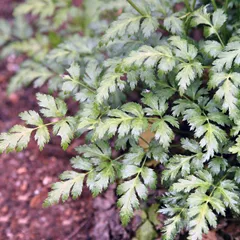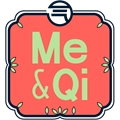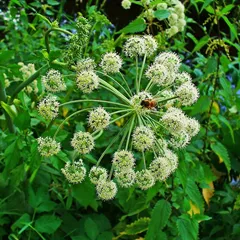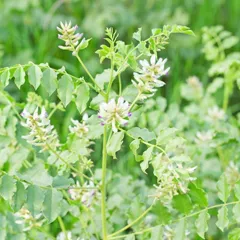Menstrual cramps according to Chinese Medicine
The information provided here is not a replacement for a doctor. You shouldn't use it for the purpose of self-diagnosing or self-medicating but rather so you can have a more informed discussion with a professional TCM practitioner.
Dysmenorrhea, Dysmenorrhoea and Painful periods redirect here
Menstrual cramps factsheet
Chinese name: 痛经
Pinyin name: Tòng Jīng
Possible causes and remedies:
Symptoms: Sore back Sore legs Pale face and seven other symptoms
Recommended formula: Wen Jing Tang and two other formulas
Stagnant Liver-Qi turning into Fire
Symptoms: Anger Thirst Red face and eleven other symptoms
Recommended formula: Xuan Yu Tong Jing Tang and one other formula
Menstrual cramps refers to the pain that comes before, during or after the period. It can appears in the lower abdominal, sacral area and it sometimes spread to the legs. Some women might even suffer from nausea, fever, vomiting or fainting.
The Penetrating Vessel (Chong Mai 冲脉), the Directing Vessel (Ren Mai 任脉)and the Liver are the most influential body parts on the menstrual cycle according to Chinese Medicine. The proper flow of menstrual blood depends on the free movement of Liver Qi and Penetrating Vessel Qi. Also Blood should be sufficient and flow without Stagnation.
We explain here the various pathological reasons explaining menstrual cramps from the Traditional Chinese Medicine point of view.
As you can see below we've detailed for you the six "patterns of disharmony" associated with menstrual cramps. Chinese Medicine sees the body as a system, not a sum of isolated parts. A "pattern" is when the system's harmony is disrupted. It is not equivalent to a Western condition, as a matter of fact here menstrual cramps can be explained by six different patterns.
Each of those patterns can be treated with one or several herbal formulas. Drinking herbal infusions is the most common remedy in Chinese Medicine, together with acupuncture. It is the Chinese Medicine equivalent to drugs, apart that it's 100% natural!
In total we detail below fifteen formulas that can help treat the various patterns that cause menstrual cramps, depending on which pattern fits your profile.
The six "patterns of disharmony" associated with menstrual cramps

Cinnamon Twigs (Gui Zhi) is the key herb for Wen Jing Tang, a formula used for Cold in the Uterus
Cold in the Uterus
Pulse type(s): Choppy (Se), Deep (Chen), Tight (Jin)
Tongue color: Bluish-Purple, Pale
Recommended herbal formulas: Wen Jing Tang, Shao Fu Zhu Yu Tang, Wen Qi Hua Shi Tang
Symptoms: Sore back Sore legs Pale face Cold limbs Scanty periods Feeling of cold Frequent urination Lower abdominal pain Pain relieved with heat Dark clots in menstrual blood
'Cold in the Uterus' is one the most common TCM patterns for women who suffer from dysmenorrhea. It can causes intense pain but can be largely relieved with the application of heat. Blood Stagnation often comes along as a consequence of this pattern because Cold obstructs the Uterus and thus impairs the flow of Blood.
If Cold in the Uterus is the main cause behind menstrual cramps, the menstrual blood is often red and the clots are typically dark and rather small or stringy. However, if Blood Stagnation is the main cause, the blood itself is dark (instead of red) and the clots are rather large.
There are two subtypes of Cold in the Uterus patterns: Full Cold or Empty Cold.
Full cold refers to actual Cold Evil invading the Uterus. It tends to happen to women who consume excessive amount of cold food (e.g. ice cream, raw food, ice-cold drinks), live in cold environment or do sports in winter or during menstruation. Dampness Stagnation often come along with this Full Cold pattern. The treatment principle is to use herbs that expel Cold and Dampness and warm the Uterus. Formulas like Shao Fu Zhu Yu Tang are recommended.
Empty Cold is linked to Yang Deficiency, especially in the Spleen and Kidney. With Yang Deficiency in these two Organs, body water metabolism is impaired and thus Coldness in the Body Fluids can not be transferred and accumulates. Also, when Yang is lacking, it can not warm the necessary Organs. As a result, treating Empty Cold only with herbs that expel Coldness is not enough, the treatment should focus on supporting Yang and boosting Qi. Wen Qi Hua Shi Tang is a good formula for this. It is used for long-term retention of Cold and Dampness in the Uterus which leads to Qi and Yang Deficiency and painful periods.

The Liver is a so-called "Zang" Organ. Learn more about the Liver in Chinese Medicine
Stagnant Liver-Qi turning into Fire
Pulse type(s): Rapid (Shu), Wiry (Xian)
Tongue coating: Yellow coating
Tongue color: Red
Recommended herbal formulas: Xuan Yu Tong Jing Tang, Jia Wei Xiao Yao San
Symptoms: Anger Thirst Red face Red lips Dizziness Dry stools Irritability Heavy periods Abdominal pain Feeling of heat Menstrual cramps Sore and weak limbs Dark menstrual blood Bitter taste in the mouth
The cramps caused by this pattern usually happens before or during the period. The symptoms are similar to these from Liver Qi Stagnation but more intense. The menstrual blood is dark purple and the flow is heavy. The patients is often irritable and gets angry easily. They feel thirsty and have a sensation of heat in their body. Dry stools is also a typical symptom.
Liver Fire is a consequence of a long-term Stagnation of Liver-Qi. It should be treated by eliminating Stagnation rather than simply clearing Heat with bitter-cold herbs.

Phellodendron Bark (Huang Bo) is the key herb for Er Miao San, a formula used for Damp-Heat
Damp-Heat
Pulse type(s): Rapid (Shu), Slippery (Hua)
Tongue coating: Sticky coating, Yellow coating
Tongue color: Red
Recommended herbal formulas: Er Miao San, Xiao Yao San, Qing Re Tiao Xue Tang
Symptoms: Fever Thirst Dry mouth Restlessness Heavy periods Feeling of heat Sore lower back Abdominal fullness Abdominal tightness Sore and weak limbs Lower abdominal pain Feeling of heaviness Thick menstrual blood Scanty and dark urine Feeling of bearing down Purplish menstrual blood Smelly Vaginal discharge Bitter taste in the mouth Small clots in menstrual blood
When Damp-Heat causes menstrual cramps a feeling of lower abdominal tightness, distention, and cramps appears and gets stronger when the period is about to start. The discomfort lasts until the middle of the periods. The menstrual flow is often heavy and the blood is purplish in color and thick in texture. Other typical symptom can be an excessive smelly yellow vaginal discharge outside of menstruation times.
When patients have a history of pelvic inflammatory disease, chronic vaginitis, or appendicitis, they tend to have bigger chance falling under this pattern. The cramps can be either on both sides or just on one side, which tends to be the lower right side of the abdominals. Also, women suffering from this pattern might have a sore back and limbs as well as feel pain and heat in the knees.

Bupleurum Roots (Chai Hu) is the key herb for Xiao Yao San, a formula used for Qi and Blood Stagnation
Qi and Blood Stagnation
Pulse type(s): Choppy (Se), Wiry (Xian)
Tongue color: Normal (light red), Red, Red sides
Recommended herbal formulas: Xiao Yao San, Tao Hong Si Wu Tang, Ge Xia Zhu Yu Tang
Symptoms: Restlessness Scanty periods Clots in blood Breast distention Intense period pain Lower abdominal pain Dark menstrual blood Pre-menstrual tension Pre-menstrual irritability Dark clots in menstrual blood Abdominal distention and fullness Pain relief after clots discharge
Qi and Blood Stagnation is one of the most common patterns behind painful periods and it often comes along other patterns. For instance, when there is dysmenorrhea due to Qi and Blood Deficiency as the main pattern, some degree of Qi or Blood Stagnation often occurs at the same time. Similarly the pattern Cold in the Uterus, another frequent cause of menstrual cramps, also causes Blood Stagnation.
According to Chinese Medicine, the Liver and the Penetrating Vessel are the body parts most involved in Qi and Blood Stagnation. If Liver Qi does not flow freely, Blood stagnates and causes pain before and during the period. As for the Penetrating Vessel, it notably supplies and coordinates Blood to the Uterus, a function that's impaired if Liver Qi and Blood stagnate.
When the menstrual cramps are mainly due to Qi Stagnation, abdominal distension is the most obvious symptoms, especially one or two days before menstruation or at the very beginning of the periods. The condition is aggravated by emotional upset and stress. Pre-menstrual tension, irritability, depression and a wiry pulse are other symptoms. The tongue color is often normal, except in serious and chronic cases when it may be red on the sides.
If Blood Stagnation is more prominent, there is more pain than distention and the pain tends to be intense and stabbing. The flow doesn't go easily and it tends to be scanty as well as dark and purplish in color. Often there are dark clots in the blood, which is the typical indicator of this pattern. The larger the clots, the more severe the Stagnation. There is usually a relief of pain after blood clots are discharged. Purple color tongue is also a typical symptom.

Motherwort Herbs (Yi Mu Cao) is the key herb for Ba Zhen Yi Mu Tang, a formula used for Qi and Blood Deficiency
Qi and Blood Deficiency
Pulse type(s): Choppy (Se)
Tongue color: Pale
Recommended herbal formulas: Ba Zhen Yi Mu Tang, Sheng Yu Tang
Symptoms: Edema Pale face Pale lips Tiredness Dizziness Sore back Sore knees Loose stools Scanty periods Pale color periods Shortness of breath Dull menstrual cramps Feeling of bearing down Thin and watery periods Pain relieved with massage
Qi and Blood Deficiency often only causes dull menstrual cramps. Even in painful periods caused by a Deficiency there is often also an element of Stagnation because Qi can not move Blood properly, which is what leads to dysmenorrhea. It often come along with a dragging feeling around the perineum that can be relieved by massage. There are no clots in the menstrual blood, but the blood is scanty and thin with a pale color.
The cramps often happen towards the end of or after the period. It is because the Penetrating Vessel's 'Sea of Blood' is empty after releasing menstrual blood and there is not enough Qi to move the Blood back in.
The treatment principle is to tonify Qi, nourish Blood and strengthen the Spleen which is the base of producing additional Qi and Blood.

The Kidneys is a so-called "Zang" Organ. Learn more about the Kidneys in Chinese Medicine
Liver Blood and Kidney Yin Deficiency
Pulse type(s): Empty (Xu), Floating (Fu)
Tongue coating: Complete absence of coating
Tongue color: Red
Recommended herbal formulas: Tiao Gan Tang, Gui Shao Di Huang Tang, Liu Wei Di Huang Wan
Symptoms: Fatigue Tinnitus Sore back Dizziness Scanty periods Blurred vision Delayed period Dull menstrual cramps Pain relieved with massage
Like with the Blood and Qi Deficiency pattern, dysmenorrhea caused by Liver Blood and Kidney Yin Deficiency also causes dull pain and often come towards the end of or after the period. It is more often seen in older, premenopausal women.
In this pattern, the menstrual cramps occur because there is no sufficient Liver Blood and Kidney Yin to fill the Uterus and to nourish the sinews. The pain often extends to the top of the thighs along the course of the Liver Channel. The treatment principles is to nourish Liver Blood and Kidney Yin, tonify the Uterus and nourish the Essence.
The fifteen herbal formulas that might help with menstrual cramps



The top herbs in Xiao Yao San are Bupleurum Roots (Chai Hu), Dong Quai (Dang Gui) and White Peony Roots (Bai Shao)
Xiao Yao San
Source date: 1107 AD
Number of ingredients: 6 herbs
Key actions: Harmonizes the function of Liver and Spleen. Relieves Liver Qi stagnation. Nourishes the Blood.
Why might Xiao Yao San help with menstrual cramps?
Because it is a formula often recommended to help with the patterns Damp-Heat and Qi and Blood Stagnation which are sometimes associated with menstrual cramps. If any of these patterns look like something you might suffer from, this formula might help (although please seek confirmation with a professional practitioner beforehand).



The top herbs in Wen Jing Tang are Cinnamon Twigs (Gui Zhi), Evodia Fruits (Wu Zhu Yu) and Dong Quai (Dang Gui)
Wen Jing Tang
Source date: 220 AD
Number of ingredients: 12 herbs
Key actions: Warms the Uterus and vessels. Nourishes Blood. Dispels Cold. Dispels Blood Stagnation.
Why might Wen Jing Tang help with menstrual cramps?
Because it is a formula often recommended to help treat Cold in the Uterus, a pattern sometimes associated with menstrual cramps. If it looks like you might suffer from Cold in the Uterus, this formula might help (although please seek confirmation with a professional practitioner beforehand).



The top herbs in Xuan Yu Tong Jing Tang are White Peony Roots (Bai Shao), Dong Quai (Dang Gui) and Mudan Peony Bark (Mu Dan Pi)
Xuan Yu Tong Jing Tang
Source date: 1826 AD
Number of ingredients: 10 herbs
Key actions: Pacifies the Liver. Removes Stagnation. Drains Fire. Unblocks the Meridians.
Why might Xuan Yu Tong Jing Tang help with menstrual cramps?
Because it is a formula often recommended to help treat Stagnant Liver-Qi turning into Fire, a pattern sometimes associated with menstrual cramps. If it looks like you might suffer from Stagnant Liver-Qi turning into Fire, this formula might help (although please seek confirmation with a professional practitioner beforehand).



The top herbs in Ba Zhen Yi Mu Tang are Motherwort Herbs (Yi Mu Cao), Prepared Rehmannia (Shu Di huang) and Ginseng (Ren Shen)
Ba Zhen Yi Mu Tang
Source date: 1624 AD
Number of ingredients: 9 herbs
Key actions: Tonifies Qi and Blood. Invigorates the Blood.
Why might Ba Zhen Yi Mu Tang help with menstrual cramps?
Because it is a formula often recommended to help treat Qi and Blood Deficiency, a pattern sometimes associated with menstrual cramps. If it looks like you might suffer from Qi and Blood Deficiency, this formula might help (although please seek confirmation with a professional practitioner beforehand).



The top herbs in Tiao Gan Tang are Dong Quai (Dang Gui), White Peony Roots (Bai Shao) and Yam (Shan Yao)
Tiao Gan Tang
Why might Tiao Gan Tang help with menstrual cramps?
Because it is a formula often recommended to help treat Liver Blood and Kidney Yin Deficiency, a pattern sometimes associated with menstrual cramps. If it looks like you might suffer from Liver Blood and Kidney Yin Deficiency, this formula might help (although please seek confirmation with a professional practitioner beforehand).



The top herbs in Shao Fu Zhu Yu Tang are Szechuan Lovage Roots (Chuan Xiong), Fennel Seeds (Xiao Hui Xiang) and Dried Ginger (Gan Jiang)
Shao Fu Zhu Yu Tang
Source date: 1830 AD
Number of ingredients: 10 herbs
Key actions: Expels Cold and warm the menstruation Blood. Stops pain. Invigorates Blood. Dispels Blood stagnation.
Why might Shao Fu Zhu Yu Tang help with menstrual cramps?
Because it is a formula often recommended to help treat Cold in the Uterus, a pattern sometimes associated with menstrual cramps. If it looks like you might suffer from Cold in the Uterus, this formula might help (although please seek confirmation with a professional practitioner beforehand).



The top herbs in Wen Qi Hua Shi Tang are Atractylodes Rhizomes (Bai Zhu), Poria-Cocos Mushrooms (Fu Ling) and Morinda Roots (Ba Ji Tian)
Wen Qi Hua Shi Tang
Source date: 1827 AD
Number of ingredients: 7 herbs
Key actions: Supports Kidney Yang. Supplies Spleen Qi. Expels Cold and Dampness from the Uterus.
Why might Wen Qi Hua Shi Tang help with menstrual cramps?
Because it is a formula often recommended to help treat Cold in the Uterus, a pattern sometimes associated with menstrual cramps. If it looks like you might suffer from Cold in the Uterus, this formula might help (although please seek confirmation with a professional practitioner beforehand).



The top herbs in Jia Wei Xiao Yao San are Bupleurum Roots (Chai Hu), Dong Quai (Dang Gui) and White Peony Roots (Bai Shao)
Jia Wei Xiao Yao San
Source date: Ming dynasty
Number of ingredients: 10 herbs
Key actions: Clears Liver and Spleen Qi Stagnation. Tonifies Spleen. Clears Deficient Heat. Nourishes the blood.
Why might Jia Wei Xiao Yao San help with menstrual cramps?
Because it is a formula often recommended to help treat Stagnant Liver-Qi turning into Fire, a pattern sometimes associated with menstrual cramps. If it looks like you might suffer from Stagnant Liver-Qi turning into Fire, this formula might help (although please seek confirmation with a professional practitioner beforehand).



The top herbs in Er Miao San are Phellodendron Bark (Huang Bo) and Black Atractylodes Rhizomes (Cang Zhu)
Er Miao San
Source date: 1481 AD
Number of ingredients: 2 herbs
Key actions: Expels Dampness from the Lower Burner. Drains Heat from the Lower Burner.
Why might Er Miao San help with menstrual cramps?
Because it is a formula often recommended to help treat Damp-Heat, a pattern sometimes associated with menstrual cramps. If it looks like you might suffer from Damp-Heat, this formula might help (although please seek confirmation with a professional practitioner beforehand).



The top herbs in Qing Re Tiao Xue Tang are Mudan Peony Bark (Mu Dan Pi), Unprepared Rehmannia (Di Huang) and Goldthread Rhizomes (Huang Lian)
Qing Re Tiao Xue Tang
Source date: 1576 AD
Number of ingredients: 10 herbs
Key actions: Expel Dampness. Relieve pain. Move Qi and Blood.
Why might Qing Re Tiao Xue Tang help with menstrual cramps?
Because it is a formula often recommended to help treat Damp-Heat, a pattern sometimes associated with menstrual cramps. If it looks like you might suffer from Damp-Heat, this formula might help (although please seek confirmation with a professional practitioner beforehand).



The top herbs in Tao Hong Si Wu Tang are Peach Kernels (Tao Ren), Safflowers (Hong Hua) and Dong Quai (Dang Gui)
Tao Hong Si Wu Tang
Source date: 1291 AD
Number of ingredients: 6 herbs
Key actions: Tonifies Blood and regulates the Liver. Moves Qi and Blood in the lower abdomen. Stops pain.
Why might Tao Hong Si Wu Tang help with menstrual cramps?
Because it is a formula often recommended to help treat Qi and Blood Stagnation, a pattern sometimes associated with menstrual cramps. If it looks like you might suffer from Qi and Blood Stagnation, this formula might help (although please seek confirmation with a professional practitioner beforehand).



The top herbs in Ge Xia Zhu Yu Tang are Szechuan Lovage Roots (Chuan Xiong), Safflowers (Hong Hua) and Peach Kernels (Tao Ren)
Ge Xia Zhu Yu Tang
Source date: 1830 AD
Number of ingredients: 12 herbs
Key actions: Invigorates Blood. Eliminates Blood Stagnation below the diaphragm. Stops pain. Promotes Qi movement.
Why might Ge Xia Zhu Yu Tang help with menstrual cramps?
Because it is a formula often recommended to help treat Qi and Blood Stagnation, a pattern sometimes associated with menstrual cramps. If it looks like you might suffer from Qi and Blood Stagnation, this formula might help (although please seek confirmation with a professional practitioner beforehand).



The top herbs in Sheng Yu Tang are Dong Quai (Dang Gui), Ginseng (Ren Shen) and Milkvetch Roots (Huang Qi)
Sheng Yu Tang
Source date: 1336 AD
Number of ingredients: 6 herbs
Key actions: Tonifies Qi and Blood. Preserves the Blood.
Why might Sheng Yu Tang help with menstrual cramps?
Because it is a formula often recommended to help treat Qi and Blood Deficiency, a pattern sometimes associated with menstrual cramps. If it looks like you might suffer from Qi and Blood Deficiency, this formula might help (although please seek confirmation with a professional practitioner beforehand).



The top herbs in Gui Shao Di Huang Tang are Prepared Rehmannia (Shu Di huang), Yam (Shan Yao) and Cornelian Cherries (Shan Zhu Yu)
Gui Shao Di Huang Tang
Why might Gui Shao Di Huang Tang help with menstrual cramps?
Because it is a formula often recommended to help treat Liver Blood and Kidney Yin Deficiency, a pattern sometimes associated with menstrual cramps. If it looks like you might suffer from Liver Blood and Kidney Yin Deficiency, this formula might help (although please seek confirmation with a professional practitioner beforehand).



The top herbs in Liu Wei Di Huang Wan are Prepared Rehmannia (Shu Di huang), Cornelian Cherries (Shan Zhu Yu) and Yam (Shan Yao)
Liu Wei Di Huang Wan
Source date: 1119 AD
Number of ingredients: 6 herbs
Key actions: Enriches the yin and nourishes the Kidneys.
Why might Liu Wei Di Huang Wan help with menstrual cramps?
Because it is a formula often recommended to help treat Liver Blood and Kidney Yin Deficiency, a pattern sometimes associated with menstrual cramps. If it looks like you might suffer from Liver Blood and Kidney Yin Deficiency, this formula might help (although please seek confirmation with a professional practitioner beforehand).
Symptoms related to menstrual cramps
Scanty periods Lower abdominal pain Sore back Dizziness Dark clots in menstrual blood Pale face Heavy periods Thirst Feeling of heat Dark menstrual blood






